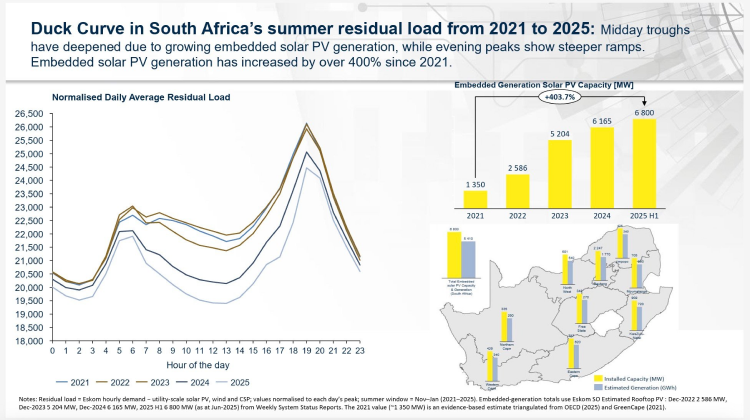Private solar power is beating Koeberg
The Council for Scientific and Industrial Research (CSIR) says private rooftop solar power supported 5% of South Africa’s electricity demand in the first half of 2025, more than the contribution of nuclear power.
Despite the substantial uptake of the technology in recent years, private solar power sceptics have alleged that the generation has had no meaningful impact on reducing load-shedding.
Eskom has also barely mentioned private solar power’s role in reducing demand for power from its stations.
Instead, the utility has focused on how its generation recovery plan has improved the reliability of its predominantly coal-powered fleet.
The CSIR’s latest Utility Statistics report found that embedded rooftop PV capacity reached 6,800 megawatt (MW) by mid-2025, an increase of 403.7% from the 1,350MW installed in 2021.
According to the CSIR, private solar power generated 5.4 terawatt-hours (TWh) in the first six months of the year, more than the 4.7TWh contributed by the Koeberg nuclear power station over the same period.
The top three provinces by capacity and energy generated were Gauteng (2,247MW and 1.7TWh), KwaZulu-Natal (909MW and 0.72TWh) and the Eastern Cape (787MW and 0.62TWh).
The CSIR said that private sector embedded generation and increased electricity tariffs were the biggest contributors to electricity demand dropping 3% year-on-year to 106.4TWh.
Another criticism of solar power is that it does not help ease peak evening electricity demand, as the sun is no longer shining at this time.
However, this ignores the fact that many households and businesses are using their stored battery energy during this period.
A recent analysis by MyBroadband found that South Africa imported roughly 24 gigawatt-hours (GWh) of lithium-ion batteries between 2020 and 2025.
These have sufficient capacity to provide the same power as Kusile or Medupi for roughly five hours or to reduce load-shedding by two stages over a 12-hour period.
Not just a daytime contributor

The CSIR also attributed a continued drop in peak evening demand to growth in embedded generation and energy efficiency interventions.
In H1 2025, the highest demand measured was 31,825MW, 3% lower than the 32,865MW recorded in the first half of 2024.
The roughly 1,000MW drop in peak time usage is equal to the demand shed through one stage of load-shedding.
That said, the CSIR said the Duck Curve — the common 24-hour trend in electricity demand that resembles a duck’s profile — has deepened.
The mid-day normalised average residual load has plummeted from 22,000MW in 2021 to 19,500MW in 2025 — a 2,500MW difference.
At the same time, normalised daily average residual load during peak periods has only decreased by 1,500MW from 26,000MW to 24,500MW.
Another way to look at this is to consider the difference between average residual load in the mid-day off-peak period — when solar generation is optimal — and the peak evening demand.
In 2021, the difference was about 4,000MW. In the first half of 2025, the gap had grown to 5,000MW, largely due to the increased contribution of solar in the day. This impact is shown in the graph below.

Energy supply a dynamic system
It is important to consider the dynamic nature of the entire energy supply system and how different sources of power can complement each other.
Eskom has explained that the increased private solar power has enabled the utility to make less use of peaking generators during the day, including its pumped dam storage schemes and open-cycle gas turbines.?
During the worst years of load-shedding, the water and diesel levels at these facilities were often depleted by the end of the week, necessitating weekend power cuts to replenish them.
The CSIR also pointed out that utility-scale solar and wind power had reduced the number of hours where total load was over 30,000MW by 157% in the first half of 2025.
However, the overall contribution of renewables in South Africa’s energy mix continues to remain limited.
Utility-scale solar and wind power generated 8.4TWh of electricity during H1 2025, similar to its contribution in the first half of 2024. Hydro power contributed another 1TWh.
Combining this with the 5.4TWh of private rooftop solar energy, roughly 14% of electricity used in the country during the first half of the year came from renewable sources.
Coal power contributed 86.2TWh, making up about 81% of the electricity consumed, while diesel and gas power contributed 2.7TWh, up 36% from the same period last year.
